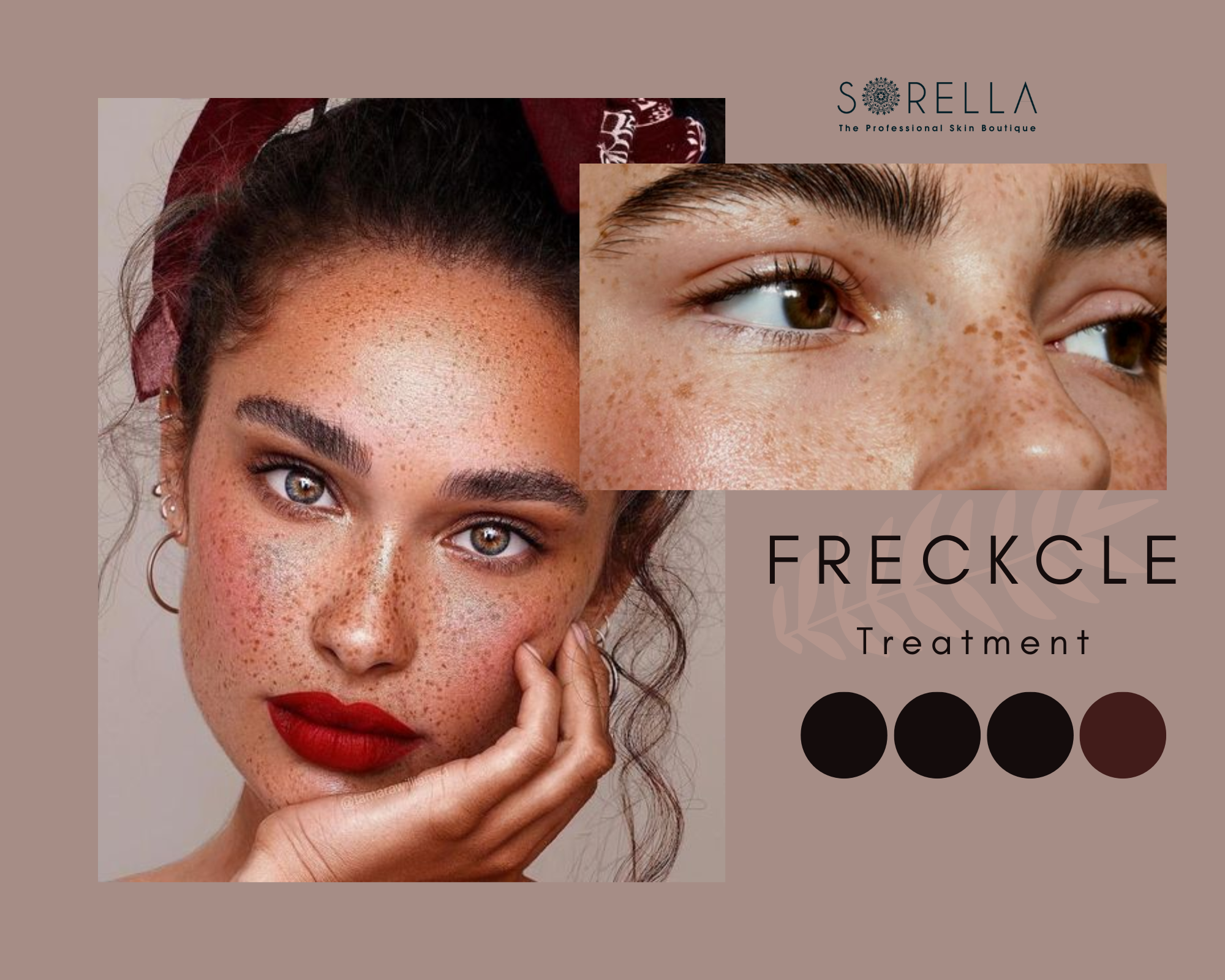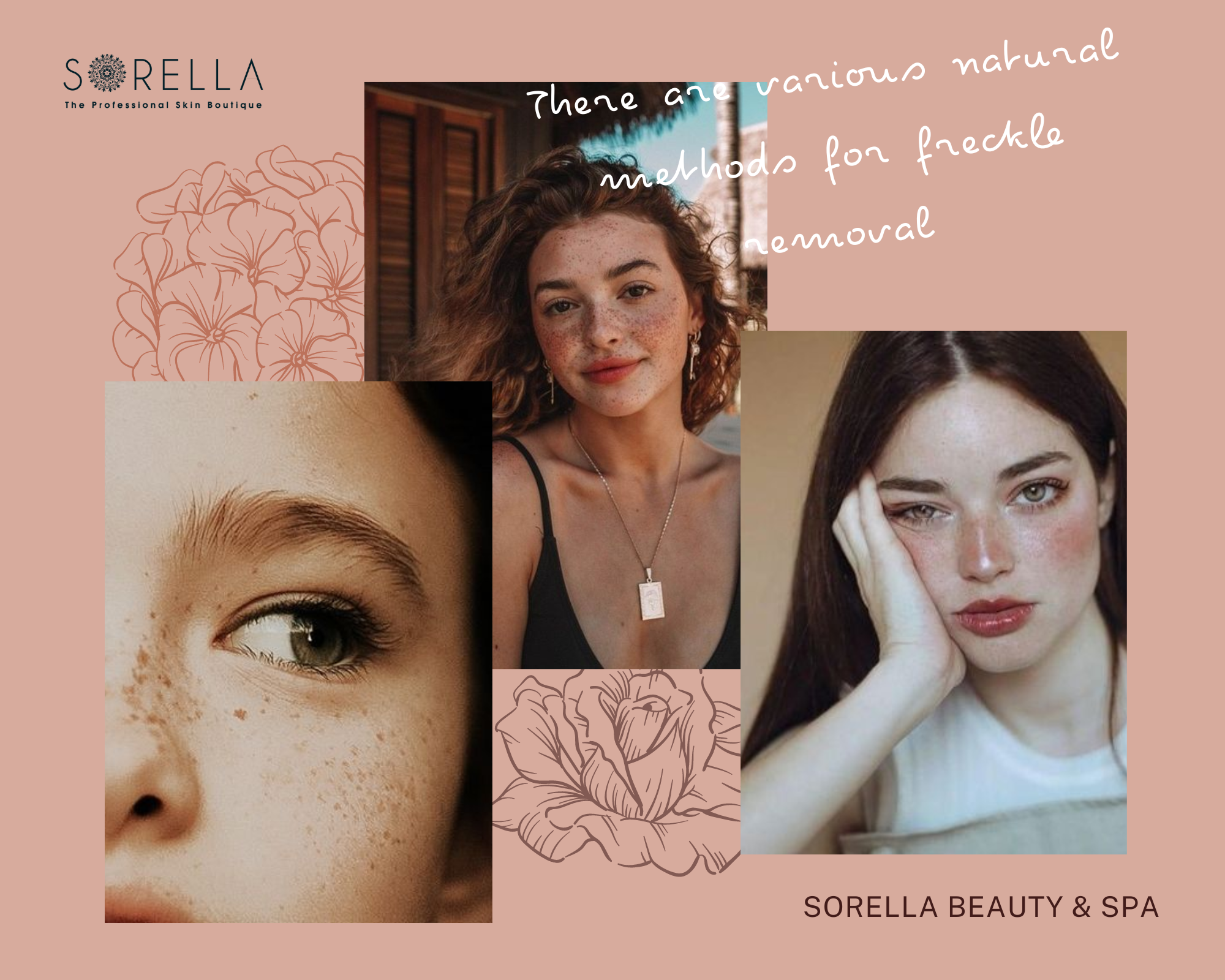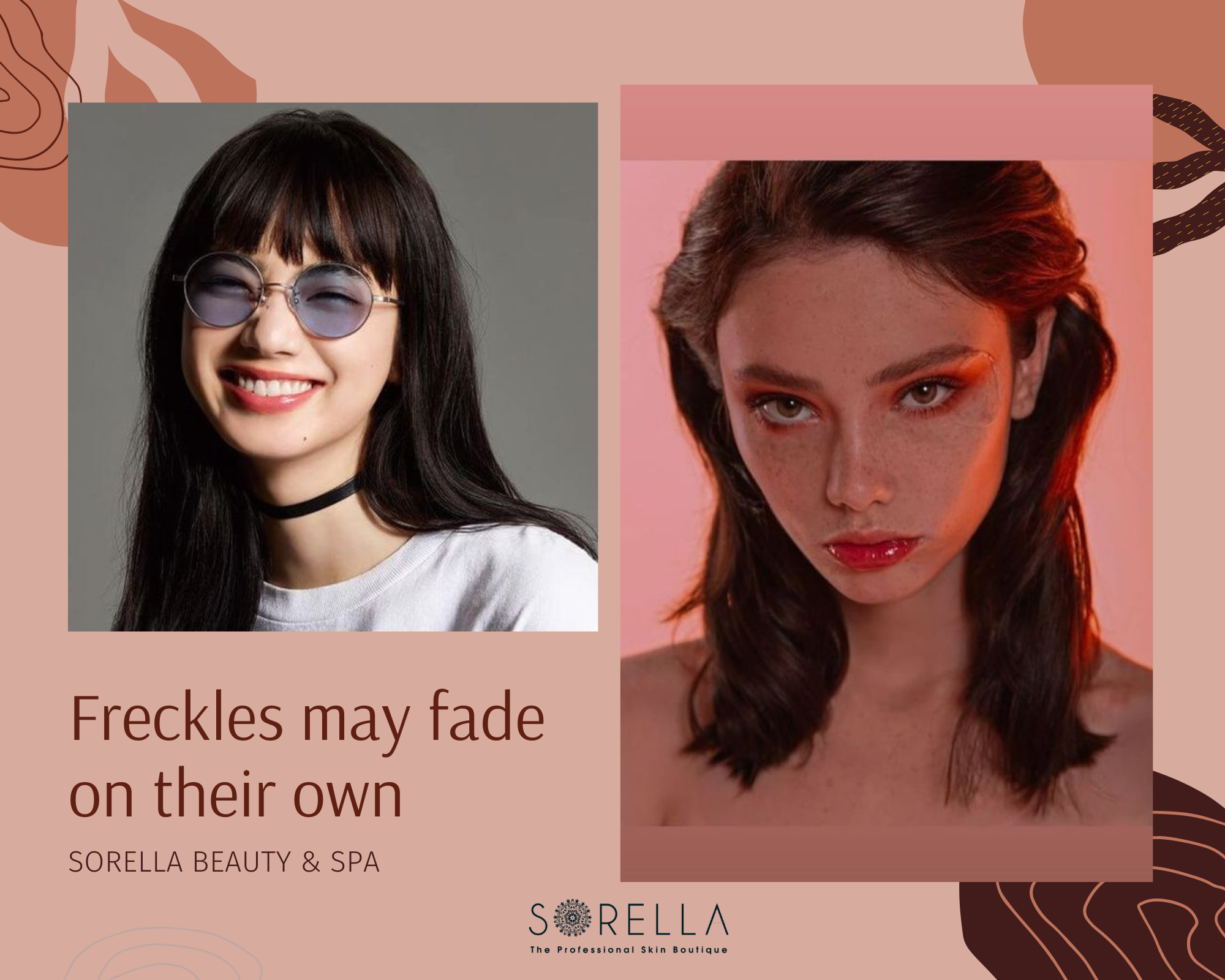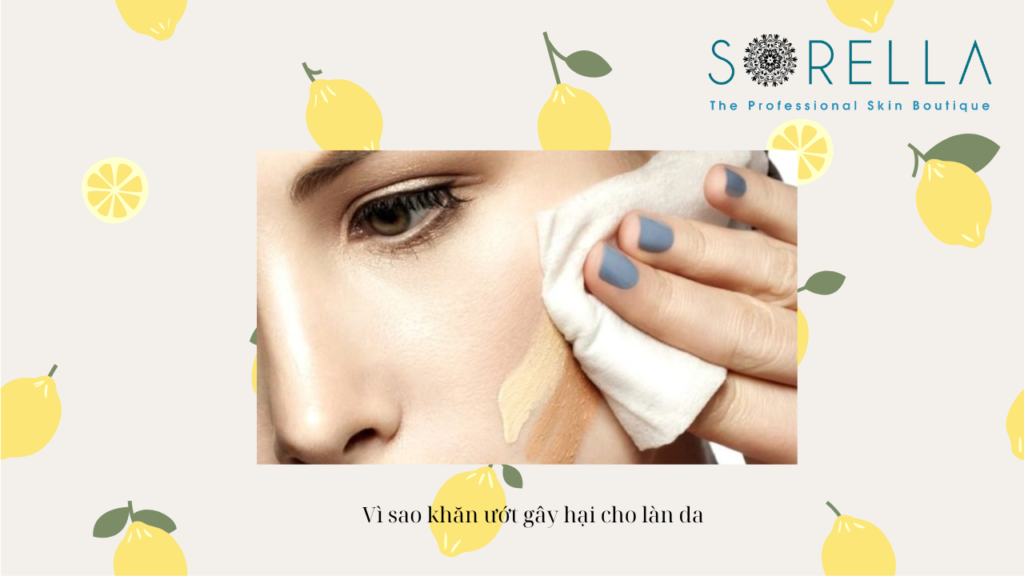Bí quyết làm đẹp
Freckles Treatment: 5+ methods to get rid of Freckles
Freckles Treatment – The sun provides several benefits, including warmth, light, and the ability of plants to photosynthesize. But what about freckles? Thank you very lot, Mr. Sun! We’d prefer not to have them! While most freckles are safe and some individuals think their freckles are attractive, this is not true for everyone so they need freckles treatment.
Why do freckles emerge?
Freckles are tan or light brown skin patches. They are composed of clusters of skin cells containing the pigment melanin. Freckles are flat, as opposed to elevated moles. Freckles are neither painful nor dangerous.

Freckles emerge primarily due to genetic predisposition and exposure to sunlight. Here’s a closer look at why freckles appear:
- Genetic Factors: Freckles can be inherited from your parents. If your parents have freckles, there is a higher chance that you will develop them as well. Genetic variations can influence the amount of melanin pigment produced in your skin, resulting in freckles.
- Melanin Production: Freckles occur when there is an overproduction of melanin, the pigment responsible for giving color to the skin, hair, and eyes. Certain individuals have cells called melanocytes that produce more melanin, leading to the formation of freckles.
- Sun Exposure: Sun exposure is a significant factor in the emergence of freckles. When the skin is exposed to sunlight, it triggers the production of melanin as a natural defense mechanism. Freckles tend to darken or become more visible when exposed to UV rays, particularly in fair-skinned individuals.
- Pigment Clustering: Freckles result from the uneven distribution of melanin in the skin. Instead of being evenly spread, the melanin pigments clump together in certain areas, forming freckles.
- Hormonal Changes: Hormonal changes, such as those occurring during puberty, pregnancy, or while taking certain medications, can stimulate the development or darkening of freckles. Hormones can influence melanin production, leading to changes in freckle appearance.
It’s important to note that freckles are typically harmless and do not require treatment. However, it’s essential to protect your skin from excessive sun exposure by wearing sunscreen, and protective clothing, and seeking shade, especially during peak sun hours. If you have concerns about your freckles or notice any changes in their appearance, it’s advisable to consult a dermatologist for proper evaluation and guidance.
Freckles Treatment – Methods to get rid of Freckles
Freckles are not hereditary, and no one is born with them. Sun exposure causes them to appear. Here are seven options to explore if you have freckles and wish to get rid of them.
Sunscreen
Sunscreen will not remove existing freckles, but it will help prevent new ones from appearing. Even when it’s gloomy, you should apply sunscreen all year.
The American Academy of Dermatology gives the following advice:
Sunscreen with an SPF of 30 or higher is recommended.
At least 15 minutes before heading outside, apply sunscreen to exposed skin.
Reapply sunscreen every two hours, especially soon after swimming or sweating profusely.
Laser therapy
Laser therapy targets damaged regions of skin with concentrated, strong light pulses. There are several types of lasers. A 2015 study found that the 1064 Q-Switched Nd YAG laser is effective for treating freckles. According to the study findings, therapy with this laser lightened more than 50% of freckles in 62 percent of patients.
Laser therapy is usually considered safe. Scarring is unlikely to occur. Other side effects, however, may occur, including:
- Itching
- Swelling
- Redness
- Crustiness
- Peeling
- Infection
- Changes in skin color
If you have a history of oral herpes, you may be required to take an antiviral drug before laser therapy. This is because the laser might induce a herpes outbreak around your mouth.
Other drugs or creams may be prescribed by your doctor before the surgery. They may also advise against taking certain drugs or using specific items before the surgery. Inform your doctor of any drugs or creams you’re using.
Recovery from laser therapy might take up to two weeks. Typically, many sessions are required to attain the desired effects.
Cryosurgery
Cryosurgery is a potential treatment option for freckles, although it is not commonly used as a primary method of treatment. Cryosurgery involves the use of extreme cold to destroy or remove abnormal tissue, including pigmented cells like freckles. Here are some key points to consider about cryosurgery for freckles:
- Procedure: During cryosurgery, a dermatologist applies liquid nitrogen or another freezing agent to the freckles using a cotton swab or spray. The cold temperature causes the freckle cells to freeze and subsequently die.
- Treatment Effectiveness: Cryosurgery can be effective in lightening or removing freckles, but the results may vary depending on the individual. Some freckles may completely disappear, while others may fade or become less noticeable.
- Side Effects: After cryosurgery, the treated area may experience temporary side effects such as redness, swelling, blistering, or scabbing. These side effects usually resolve on their own over time.
- Recovery and Follow-up: The recovery period after cryosurgery is generally short. It’s important to follow the post-treatment instructions provided by your dermatologist, which may include keeping the treated area clean and protected and avoiding sun exposure until it has fully healed.
- Considerations: Cryosurgery is typically used for the targeted treatment of individual freckles or small areas of pigmentation. It may not be suitable for large or widespread freckles. Additionally, it’s important to have a dermatologist evaluate the freckles and determine if cryosurgery is the appropriate course of action.
Before considering cryosurgery or any other freckle treatment, it’s recommended to consult with a qualified dermatologist. They can assess your specific situation, provide personalized recommendations, and discuss the potential benefits, risks, and alternatives to help you make an informed decision about your freckle treatment options.
Fading cream for the skin
Fading cream, often known as bleaching cream, is accessible without a prescription and over the counter. Many fading creams contain hydroquinone, which is supposed to decrease melanin synthesis and lighten darker skin regions.
The use of topical hydroquinone cream may result in:
- Inflammation
- Dryness
- Burning
- Blistering
- Skin discoloration
In 1982, the United States Food and Drug Administration (FDA) deemed bleaching treatments containing up to 2% hydroquinone to be generally safe and effective. In 2006, fresh research suggested that hydroquinone may cause cancer in rats, as well as skin discoloration and disfigurement. This prompted the FDA to recommend that hydroquinone be studied further under the National Toxicology Program. (NTP).
Retinoid cream for the skin
Retinoid cream contains vitamin A. It is used to lighten freckles and repair sun-damaged skin. Retinoids may provide photoprotection by absorbing ultraviolet B radiation, according to a 2014 reviewTrusted Source. This may aid in the prevention of new freckles.
Retinoid creams can be purchased either with or without a prescription. The following are common side effects:
- Redness
- Dryness
- Skin irritation
- Peeling
- Sensitivity
Chemical peel
A chemical peel exfoliates and peels off patches of damaged skin using a chemical solution. To eliminate freckles, a mild skin peel comprising glycolic acid or trichloroacetic acid penetrates the skin’s middle layers. When damaged skin is removed, new skin is formed.
Chemical peels may briefly cause:
- Stinging
- Peeling
- Redness
- Irritation
- Crusting
- Swelling
Moderate skin peels might take up to two weeks to recover, according to the American Society for Dermatologic Surgery. Every day, bathe your skin and apply a topical ointment. You’ll also need to take antiviral medication for up to two weeks and avoid the sun until your skin heals.
Natural cures

There are various natural methods for freckle removal that individuals swear by. None of these have been scientifically confirmed. Even so, when taken in moderation, most are unlikely to cause harm.
Among these natural therapies are:
- Lemon juice: Using a cotton ball, apply lemon juice straight to your skin and then wash it off. Lemon juice is said to brighten the skin.
- Honey: To make a scrub, combine honey with salt or sugar. Honey may aid in the lightening of pigmentation.
- Buttermilk: Apply buttermilk on your skin immediately. You should keep it on for 10 minutes before washing it off with warm water. A mask can also be made by blending buttermilk and oats. Buttermilk contains lactic acid, which may help fade your freckles.
- Sour cream: Apply sour cream straight to your skin for a few minutes, then wash it off. Sour cream, like buttermilk, contains lactic acid.
- Yogurt: Dab some yogurt on your skin and keep it on for a few minutes. Lactic acid is also found in yogurt.
- Onion: Apply the onion to your skin and then rinse it with warm water. Onion has exfoliating properties and may help lighten stains.
If you suffer any irritation, discontinue the use of the treatment.
What are the causes of freckles?
What are the causes of freckles? Melanocytes are cells in your skin that create the color melanin. Melanin protects your skin from UV radiation from the sun. Sunlight stimulates melanocytes to create more melanin. Freckles are caused by a buildup of melanin on the outer layer of your skin.
Although anybody may develop freckles, most people with a lot of them have pale skin. Even though persons with fair skin create less melanin than those with a darker complexion, their melanocytes produce more melanin when exposed to sunlight.
Freckles are small, flat, brown spots that appear on the skin, particularly in areas exposed to the sun. They are caused by increased production of melanin, the pigment responsible for giving color to the skin, hair, and eyes. The main cause of freckles is sun exposure, but other factors can contribute to their development:
- Genetics: Freckles can be inherited genetically. If your parents or close relatives have freckles, you are more likely to develop them as well.
- Sun exposure: Exposure to the sun’s ultraviolet (UV) rays stimulates the production of melanin in the skin. Freckles tend to darken or become more pronounced with sun exposure, especially during the summer months.
- Fair skin: People with fair or light skin are more prone to developing freckles. The higher concentration of melanin in darker skin provides more natural protection against sun damage.
- Hormonal changes: Hormonal changes during pregnancy, puberty, or while taking hormonal medications can trigger the development or darkening of freckles.
- Age: Freckles can become more prominent with age. Over time, cumulative sun exposure can lead to an increase in the number and intensity of freckles.
It’s important to note that freckles are generally harmless and do not require medical treatment. However, if you notice any changes in the appearance of your freckles, such as irregular borders, color variations, or size enlargement, it’s recommended to consult a dermatologist for further evaluation.
Freckles may fade on their own

Some freckles are sticking around for the long term. Others are more visible in the summer because of greater sun exposure but disappear in the winter or by avoiding direct sunshine. Hereditary freckles may fade as you become older. Freckles induced by sun exposure tend to get worse as you get older.
Freckles are generally harmless and may fade on their own over time, especially with reduced sun exposure. Here are some key points to consider regarding the natural fading of freckles:
- Sun Protection: Freckles tend to darken or become more pronounced with sun exposure. By protecting your skin from excessive sunlight, wearing sunscreen, and seeking shade, you can help prevent further darkening or the development of new freckles. Over time, with reduced sun exposure, existing freckles may gradually fade.
- Seasonal Changes: Freckles may appear more prominent during the summer months when sun exposure is higher. As the seasons change and sun exposure decreases, freckles may naturally lighten or become less noticeable.
- Age: Freckles can become less prominent as you age. With time, the production of melanin may decrease, leading to a natural fading of freckles. However, this varies from person to person.
- Skin Renewal: The skin naturally undergoes a process of renewal, where older skin cells are shed and replaced by new ones. As this process occurs, freckles may fade over time.
It’s important to note that freckles are a natural characteristic of the skin and do not require medical treatment. However, if you have concerns about your freckles or notice any changes in their appearance, it’s advisable to consult a dermatologist for proper evaluation and guidance.
Remember to embrace and appreciate your natural features, including your freckles. If you prefer to minimize their appearance, consider using makeup or other cosmetic techniques to temporarily conceal or reduce their visibility.
When should you see a doctor?
Freckles are not malignant, yet they might be mistaken for skin cancer. Excessive sun exposure increases the risk of both freckles and melanomas. Melanoma is more frequent in those with pale or freckled skin than in those with a dark complexion.
Consult your doctor or dermatologist if you observe changes in the size, color, or form of a freckle. They’ll be able to evaluate whether there’s cause for alarm.
If you notice changes in the size, color, or shape of a freckle, see your doctor or dermatologist. They’ll be able to determine whether it’s a reason for concern
The bottom line for freckle treatment
Freckles are widespread and harmless, but many individuals wish to remove them for cosmetic reasons. Invasive treatments like laser therapy and chemical peels are effective, but they take a long time to cure and can have major adverse effects.
- Sun Protection: The most important aspect of freckle management is sun protection. Since sun exposure is a primary trigger for freckles, wearing sunscreen with a high SPF, seeking shade, and wearing protective clothing can help prevent freckles from becoming darker or more prominent.
- Topical Treatments: Over-the-counter creams or lotions containing ingredients like hydroquinone, retinoids, or kojic acid may help fade freckles over time. These products work by inhibiting melanin production or promoting skin cell turnover.
- Professional Treatments: If you want a more significant reduction in the appearance of freckles, you can consider professional treatments such as laser therapy, chemical peels, or cryosurgery. These treatments target the pigmented cells and can help lighten or remove freckles, but they should be performed by a qualified dermatologist.
- Acceptance and Self-Care: It’s important to remember that freckles are a natural and harmless characteristic of the skin. Embracing and accepting your freckles can promote self-confidence and self-acceptance. Practicing good overall skin care, including gentle cleansing, moisturizing, and maintaining a healthy lifestyle, can help promote the overall health and appearance of your skin.
Remember to consult with a dermatologist or skin care professional for personalized advice and recommendations based on your specific situation. They can guide the best approach to manage or treat your freckles effectively and safely.
Tư vấn chuyên môn bài viết:
TS.BÁC SĨ NGUYỄN HỮU QUANG
Here are the articles that Sorella shares about beauty knowledge you can refer to:
Surgical vs. Non-Surgical Facial Rejuvenation Procedures 2023
Causes and 2 Ways to Cure Back and Body Acne
Massage Therapy: All You Need to Know in 2023
12 Things You Should Know About Laser Hair Removal Before Getting It
All you need to know about eyelid surgery in 2023
Inflammatory Acne: Symptoms, Types, Causes, and 3 Ways to Treatment
Bài viết cùng chủ đề:
-
Nên lựa chọn Rejuran hay Karisma?
-
So sánh Karisma và Profhilo – 2 phương pháp trẻ hóa da tầng sâu đỉnh cao
-
Cách diệt chấy rận hiệu quả ngay tại nhà, 8 phương pháp tiêu diệt chấy rận hiệu quả
-
Có nên dùng khăn ướt để tẩy trang? Cẩn thận khi dùng khăn giấy ướt giúp chăm sóc làn da của bạn, 1 vài thành phần của giáy ướt có hại cho da


 中文 (中国)
中文 (中国) 한국어
한국어 English
English





